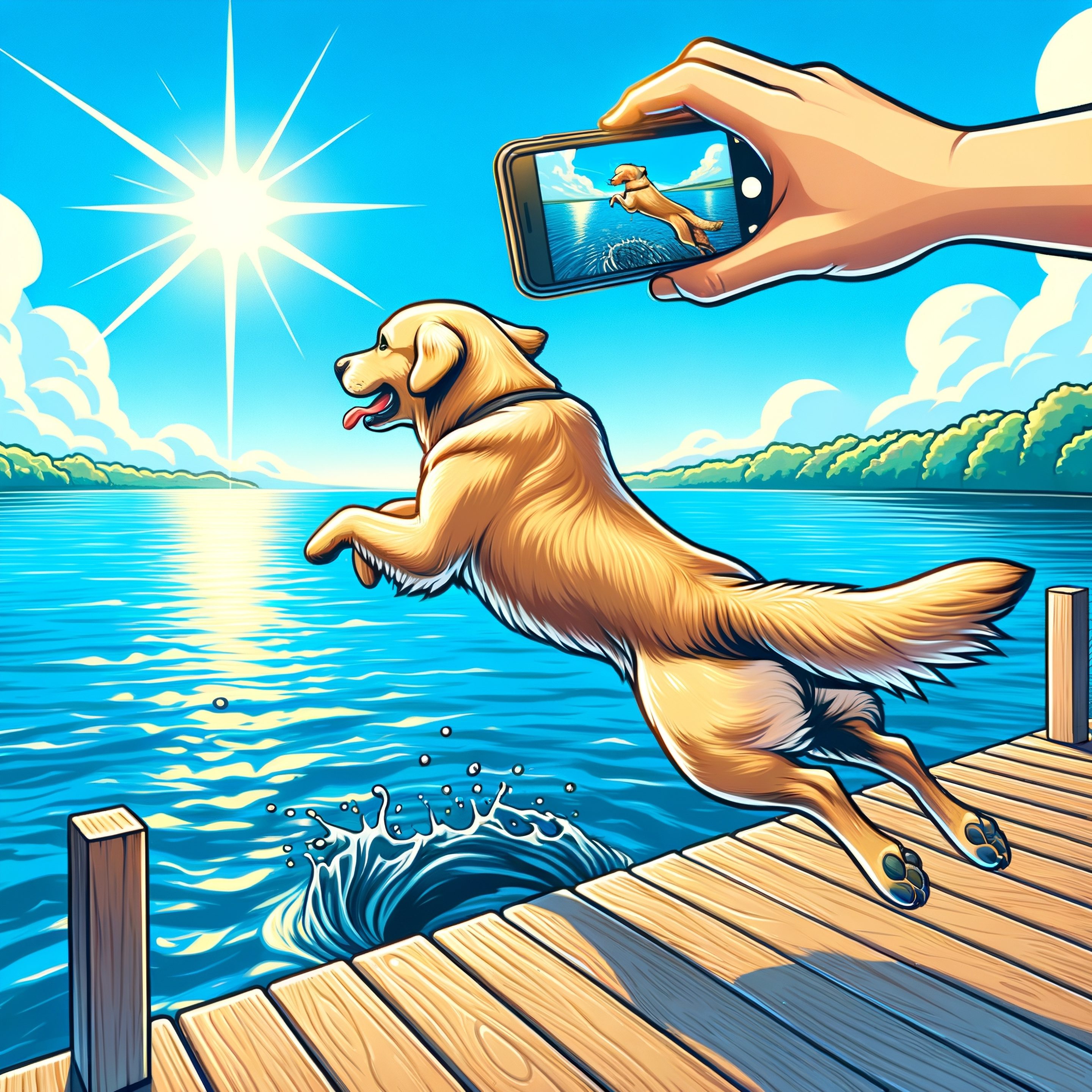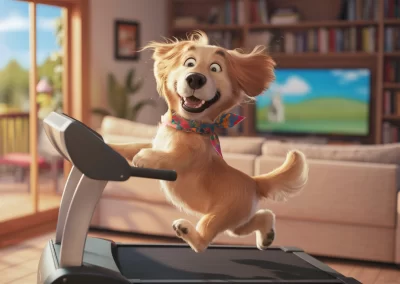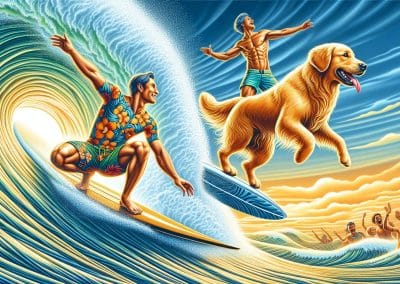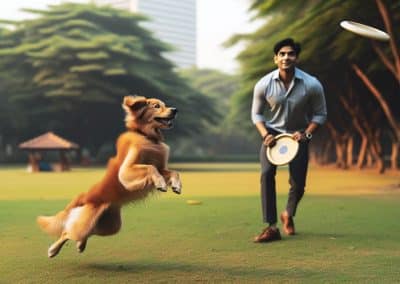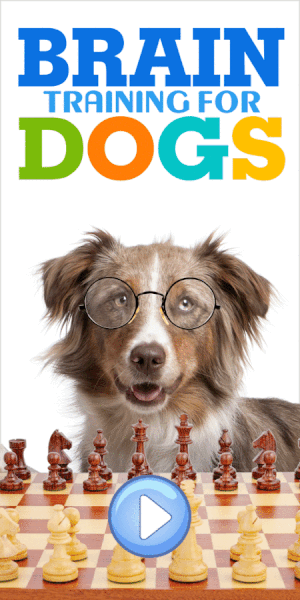Dock Diving for Goldens. Is a thrilling dog sport that combines elements of agility, speed, and swimming. It has become increasingly popular among Golden Retriever enthusiasts. These athletic dogs possess a natural love for water and are known for their ability to learn quickly, making them ideal candidates for the sport.

Golden Retrievers, with their friendly disposition and boundless energy, can find both physical exercise and mental stimulation through dock diving. This activity not only taps into their instinctive retrieving skills but also provides a low-impact workout that’s gentler on their joints compared to other high-impact dog sports. For owners, the bonding experience is equally rewarding as they work together with their Golden to improve techniques, build trust, and maybe even compete in dock diving events.
Getting started in dock diving with a Golden Retriever is a process that should be approached with enthusiasm and patience.
It’s important to cultivate a positive environment where the dog feels safe and encouraged.
Initial steps often involve getting comfortable with the water and the dock itself before progressing to actual jumps. With consistent training and a supportive approach, a Golden Retriever can soon be soaring through the air and splashing down with gusto as a burgeoning dock diving superstar.
Basics of Dock Diving
If you’re looking to get your Golden Retriever involved in a fun and engaging activity, dock diving, also known as dock jumping, is a water sport that combines athleticism and enjoyment. This sport is perfect for breeds that love water and are looking for a new challenge.
Understanding the Sport
Dock diving is an exciting water sport where dogs leap from a dock into a body of water in an attempt to achieve distance or height. The docks are typically two feet above the water. There are various organizations that oversee these events, with North America Diving Dogs (NADD) being one of the largest in the United States. Events are family-friendly and provide an excellent opportunity for dogs and owners to bond and stay active.
Key Terms and Equipment
- Dock: The platform from which dogs jump. It is usually 35 to 40 feet long, covered in artificial turf, carpet, or a rubber mat for traction.
- Thrower: The person who throws the toy or bumper to motivate the dog to jump.
- Bumper: A floatable toy often used as the object dogs aim to retrieve during the jump.
- Chase: A method where the dog is sent to run and jump after a throw toy.
Equipment Needed:
- Life Vest: For safety, especially for newer or less experienced swimmers.
- Traction Harness: To avoid slips and protect the dog when pulling them out of the water.
- Floating Toys: To encourage the dog to jump out and up.
Owners who wish to get their Golden Retrievers started in dock diving can begin with basic obedience training to ensure that their dog responds well to commands, which is crucial for safety and success in the sport.
Getting Started with Dock Diving

Dock Diving is an exciting sport that engages your Golden Retriever’s love for the water, jump, and retrieval. To begin, one should evaluate the dog’s readiness and ensure the handler is well-prepared for this rewarding activity.
Assessing Your Dog’s Readiness
Before leaping into dock diving, it’s essential to gauge whether your dog exhibits a natural inclination for the sport.
Age is a factor; young dogs often display high energy levels suitable for the sport, but they should be fully grown to avoid joint stress. A Golden Retriever’s readiness also hinges on their swimming ability and eagerness to retrieve a toy from water.
One should watch for a keen interest in water play and an aptitude for jumping and swimming.
The Role of the Handler
The handler plays a pivotal role in a dog’s success in dock diving. They are responsible for training, motivation, and ensuring the dog’s safety.
A strong bond between handler and dog aids in building confidence and enthusiasm for the sport.
Handlers should encourage their dogs with positive reinforcement, helping them associate the dock and the jump into the water with fun and excitement.
Effective communication and trust are the foundations for a successful team in dock diving competitions.
Training Your Golden Retriever
Training your Golden Retriever for dock diving involves consistency, patience, and the right approach to practice. Beginning with basic training tips helps lay the foundation for your Golden’s success, while advanced techniques will later enhance their performance and soaring distances.
Basic Training Tips
Golden Retrievers are eager to please and respond well to positive reinforcement. Starting your training with basic commands like sit, stay, and come is crucial. These commands establish your role as the trainer and maintain control during practice.
- Keep Training Sessions Short: Their attention spans can be short, so sessions should be around 10-15 minutes to maximize focus and retention.
- Exercise: Regular daily exercise is important for maintaining your Golden’s physical fitness, which is essential for a sport like dock diving.
- Retrieval Practice: Integrate fetching games into exercise routines to develop their retrieval skills, as this will be a key component of dock diving.
Advanced Techniques for Soaring Distances
Once your Golden Retriever has mastered the basics, you can move on to more advanced training techniques aimed at improving their dock diving performance.
- Build Strength and Stamina: Integrate swimming and running into your Golden’s routine to increase muscle strength and cardiovascular fitness.
- Focus on the Approach: Practice the run-up on the dock, as a fast and controlled approach can greatly impact the distance your Golden will jump.
Regardless of the training stage, remember to always end training sessions on a good note to keep their morale high.
Safety and Wellbeing

Ensuring the safety and wellbeing of Golden Retrievers is paramount during dock diving. This means taking active steps to prevent injuries and being vigilant for signs of fatigue or stress. Dock diving should be safe and fun for dogs of all experience levels.
Preventive Measures
- Water Depth: Always check that the water is sufficiently deep for jumping dogs to ensure a safe landing. Avoid shallow water to reduce the risk of injury.
- Pre-Dive Health Check: Before training or events, perform a health check to confirm a dog’s fitness for participation.
- Supervision: Keep a close watch on the dog during diving activities. An adult should always be present to supervise and intervene if necessary.
- Warm-Up and Cool-Down: Just like humans, dogs need to warm up and cool down. Begin with stretches and easy swims before advancing to jumps.
Recognizing Signs of Fatigue and Stress
- Behavioral Changes: Watch for changes in behavior. A dog that is usually eager but suddenly becomes hesitant may be experiencing stress or fatigue.
- Physical Signs: Look out for excessive panting or drooping tails. These can be indicators that the dog needs a break.
Competing in Dock Diving Events
Participating in dock diving events offers golden retrievers and their owners a thrilling way to bond and showcase their athleticism. Events are often held by various clubs, including the American Kennel Club, and cater to diving dogs of all levels, offering titles for remarkable achievements.
Different Types of Competition
There are several types of dock diving events that golden retrievers can compete in.
Distance jumping, or ‘Big Air’, measures how far dogs can leap from the end of the dock into the water.
‘Extreme Vertical’ challenges them to jump for height to grab a bumper suspended in the air.
‘Speed Retrieve’ is a timed event where dogs race to retrieve a bumper from the end of the pool.
Hosted by organizations like the North America Diving Dogs (NADD) and Ultimate Air Dogs (UAD), these competitions welcome all breeds, including Goldens, to demonstrate their prowess and earn titles.
Registering and Participating in Events
To participate, owners should first register their retrievers with a recognized organization like the American Kennel Club (AKC) or other dedicated dock diving clubs.
Checking the Complete Guide to Dock Diving can provide insight into preparing for events.
After registration, one can enter their retriever in various dock diving events through clubs such as Dock Dogs or by following scheduled events on platforms such as the NADD.
It’s important to ensure compliance with event-specific rules and to prepare dogs for competition through regular training and exercise.
Understanding Event Divisions and Titles
Dock diving showcases the athletic prowess of dogs, particularly retrievers, as they soar through the air to achieve impressive distances. This section will outline the organization of event divisions and the process of earning titles that reflect a dog’s ability and progression in the sport.
Classification of Divisions
In dock diving events, retrievers are categorized into divisions according to their jumping abilities, ensuring that competitors are evenly matched.
These divisions generally start with Novice for the beginners who reach distances up to 10 feet. They then progress through Junior, Senior, Master, and Elite for those achieving jumps over 24 feet.
Dogs may also compete in specialized divisions such as Lap, for smaller dogs, or Veterans, catering to older canines with plenty of experience but perhaps a little less spring in their step.
Organizations like the North America Diving Dogs (NADD) and the American Kennel Club (AKC) oversee these divisions. They maintain standards that allow for a fair assessment of each dog’s jumping distance during competitions.
Earning and Collecting Titles
As retrievers participate in dock diving events, they accumulate points towards achieving titles. Titles act as milestones, celebrating a dog’s progress and skill within the sport.
For instance, after frequent successful jumps, a novice retriever earns the “Dock Novice” title. As they advance, they have the opportunity to receive titles like “Dock Junior Advanced” after reaching certain benchmarks in their respective division.
The journey to collect these titles requires consistency and improvement. Higher titles such as “Dock Elite Advanced” recognize exceptional distance jumping capabilities.
Titles are significant not only as indicators of a retriever’s athletic ability but also as commemorative marks of their dedication to the sport alongside their handlers.
Mastering Specialized Dock Diving Skills

When training a Golden Retriever for dock diving, it’s essential to focus on specialized skills that can enhance their performance.
Such skills include Speed Retrieve and Air Retrieve, along with the Extreme Vertical Challenge. Success in these areas requires a combination of enthusiasm, precision, and regular practice.
Speed Retrieve and Air Retrieve
Golden Retrievers are natural athletes and thrive in dock diving disciplines like Speed Retrieve and Air Retrieve.
In Speed Retrieve, the goal is to sprint down the dock and jump into the water to retrieve an object as quickly as possible. Meanwhile, precision is key in Air Retrieve, where a bumper is suspended two feet above the dock’s edge, and the dog must leap to grab it mid-air.
- Training Tips for Speed Retrieve:
- Reinforce the dog’s recall and release commands to ensure they bring the bumper back swiftly.
- Practice starts to boost the dog’s reaction time and initial burst of speed.
- Training Tips for Air Retrieve:
- Work on the dog’s leaping ability with incremental increases in bumper height.
- Focus on timing to teach the dog to gauge the jump precisely and grab the bumper.
Tips for Extreme Vertical Challenges
In the Extreme Vertical event, dogs showcase their high-jump abilities. A notable organization for such an event is Ultimate Air Dogs, which sets benchmarks in dock diving sports.
- Key Strategies:
- Coordination: Practice jumps that allow the dog to coordinate its limbs and body for maximum lift.
- Strength: Include exercises that build hind leg strength, crucial for a powerful launch upward.
Drills for Mastery:
- Implement a gradual increase in the height target to build confidence.
- Video analysis can help owners provide targeted feedback on the dog’s form.
Building a Community and Having Fun
Dock diving is more than just a canine sport; it’s a vibrant community where Golden Retrievers and their handlers can share their passion for play and competition.
This section will focus on how to connect with other enthusiasts and ensure that both dogs and handlers maintain enjoyment in this exciting activity.
Connecting with Other Enthusiasts
Engaging with fellow dock diving aficionados is essential to building a support network and enhancing the experience for both the retrievers and their owners.
Owners can begin by joining local dock diving clubs or online forums, where they can exchange tips with seasoned participants and arrange meet-ups.
Events like big air competitions offer a fantastic venue to meet peers who also delight in the sport, creating an atmosphere of camaraderie.
Sharing experiences with others who understand the exhilarating feeling of watching a beloved Golden Retriever soar into the water only adds to the bond between dog and handler.
- Local Clubs: Join to meet others and gain access to practice facilities.
- Online Groups: Connect digitally to share photos, advice, and coordinate events.
- Dock Diving Events: Attend or participate in competitions for social and learning opportunities.
Maintaining Enjoyment and Playfulness
Dock diving is as much about play as it is about competition. Ensuring that the Golden Retrievers are having fun is paramount. Their joy is infectious and contributes to the sport’s appeal.
Integrating play into training sessions by using the retriever’s favorite toys can keep their spirits high and passion alive. It’s the sheer thrill of the splash as they launch off the dock that often proves addictive for both dogs and handlers.
Additionally, varied training with other dog sports can keep a Golden Retriever engaged and eager to participate.
Handlers should pay attention to their dog’s mood and energy levels to avoid overtraining. This ensures that dock diving remains a pleasurable activity for all involved.
- Favorite Toys: Use to motivate and engage during training.
- Variety in Training: Incorporate other sports for a well-rounded routine.
- Monitor Energy Levels: To keep diving a source of joy rather than a chore.

